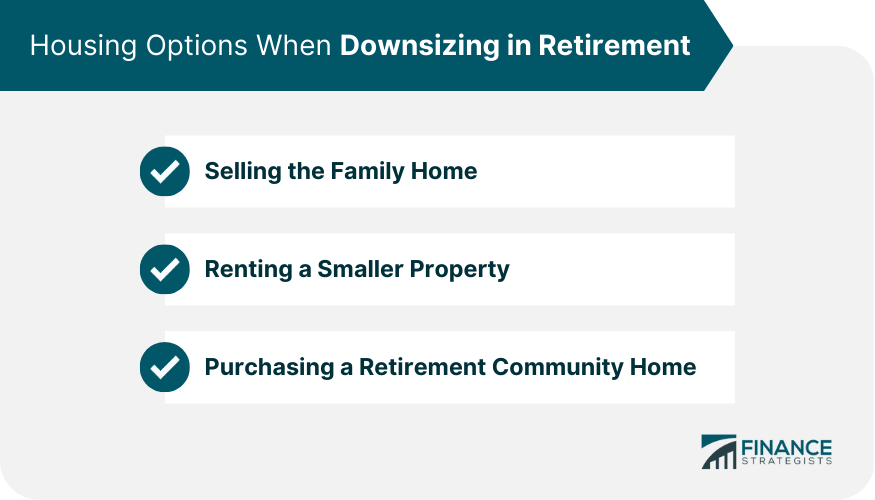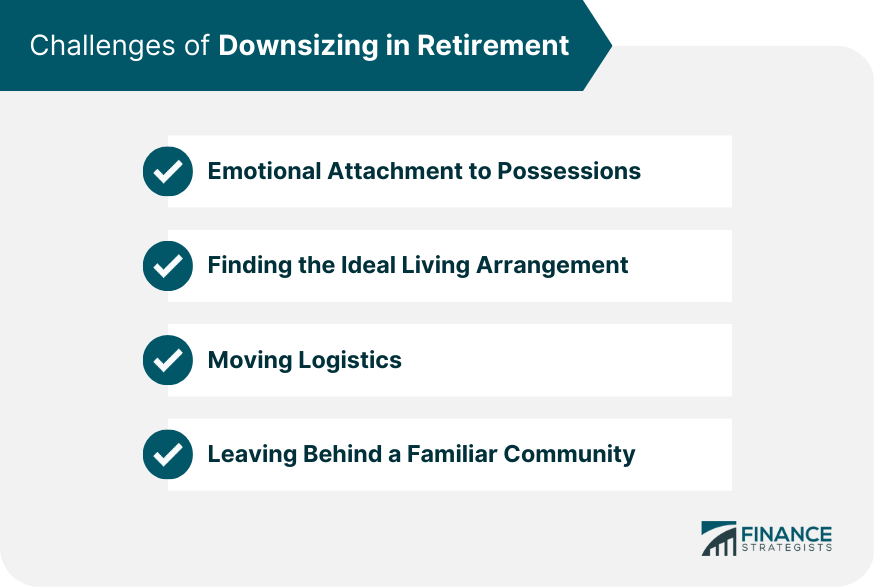Downsizing in retirement refers to the process of selling a larger home or property and moving to a smaller, more manageable living arrangement. Retirees may choose to downsize for a variety of reasons, including financial considerations, health challenges, and lifestyle preferences. Downsizing in retirement often involves decluttering and sorting possessions, as well as identifying the ideal living arrangement, such as a smaller home, apartment, or retirement community. The process of downsizing in retirement can be emotionally and physically challenging, but with proper planning and coping strategies, retirees can successfully transition to a simpler, more manageable lifestyle. Retirees often experience a decrease in income, making it challenging to maintain the expenses associated with a larger home. Downsizing can result in significant cost savings on maintenance, utilities, and property taxes. Additionally, relocating to an area with a lower cost of living can allow retirees to stretch their retirement savings further. Medical conditions and reduced mobility can make it challenging to maintain a large home. Downsizing can provide a more manageable living arrangement that better accommodates health challenges. For example, a single-story home or an apartment with elevators can reduce physical strain and make daily tasks more comfortable. Empty nesters, or individuals whose children have moved out of the family home, may find a larger home unnecessary. Downsizing can provide a simpler, more manageable lifestyle that frees up time and resources for hobbies, travel, or other interests. Additionally, retirees may simply desire a change in living arrangement and seek to simplify their life. Proper planning is essential for a successful downsizing transition. The following steps can help retirees make informed decisions about their new living arrangement: Retirees should consider their current and future housing needs when deciding when to downsize. Waiting too long to downsize can make the process more challenging physically and emotionally. However, downsizing too early can lead to unnecessary expenses, such as maintaining two properties. Retirees should consider their health, financial situation, and housing options when deciding on the best time to downsize. Retirees should consider their lifestyle and health needs when identifying their ideal living arrangement. Some popular options include smaller homes or apartments, retirement communities, assisted living facilities, or relocating to a different region or state. Retirees should also consider their social support system, transportation options, and accessibility when deciding on the ideal living arrangement. Retirees should assess their housing options based on their financial situation, lifestyle, and health needs. Some popular options include: Selling the family home is a popular option for downsizing in retirement. The sale of a larger home can provide significant financial resources for retirement. Retirees should consider the real estate market in their area, the costs associated with selling a home, and the potential tax implications of the sale. Renting a smaller property can provide retirees with a more manageable living arrangement without the financial commitment of homeownership. Retirees should consider their lease agreement, the cost of rent and utilities, and their potential for future housing needs when deciding on a rental property. Retirement communities or assisted living facilities can provide retirees with a supportive living environment and access to healthcare services. Retirees should consider the cost of a retirement community, the services provided, and the quality of care when deciding on this option. Sorting and decluttering is an essential step in downsizing in retirement. The following steps can help retirees make informed decisions about their possessions. Retirees should start by identifying which possessions they wish to keep, donate, sell, or discard. This can be a challenging process, as many items may hold sentimental or emotional value. It can be helpful to create a system for categorizing possessions, such as using different colored stickers or boxes for each category. Retirees may wish to donate or sell items they no longer need or want. Donating items can provide a sense of fulfillment, as well as a tax deduction. Selling items can provide retirees with extra income to support their downsizing transition. There are many online marketplaces, such as eBay or Facebook Marketplace, that retirees can use to sell their possessions. Retirees may need to discard items that are no longer usable or in good condition. This can be a challenging process, as many retirees may feel guilty or wasteful discarding items. However, it is important to remember that keeping unnecessary items can make the downsizing transition more challenging. Downsizing in retirement can be a challenging process, both emotionally and physically. The following are common challenges that retirees may face when downsizing: Retirees may feel emotionally attached to their possessions, making it challenging to let go of them. This can be especially true for items with sentimental or emotional value, such as family heirlooms or photographs. Retirees may find it helpful to focus on the benefits of downsizing and to seek support from family and friends. Finding the ideal living arrangement can be a challenging process. Retirees may need to consider factors such as cost, accessibility, and social support when deciding on a new living arrangement. Additionally, retirees may need to compromise on certain aspects of their ideal living arrangement, such as the location or size of the property. Moving can be a physically demanding process, especially for retirees with health challenges. Retirees may need to hire professional movers or seek help from family and friends to make the process more manageable. Additionally, retirees may need to navigate the logistics of moving, such as canceling utilities and forwarding mail. Downsizing can mean leaving behind a familiar community, such as neighbors, friends, and local amenities. This can be a challenging transition, especially for retirees who have lived in their community for many years. Retirees may find it helpful to seek out new social activities or clubs in their new community. Retirees should not hesitate to seek support from family and friends during the downsizing process. Loved ones can provide emotional support, physical help with moving, and assistance with sorting and decluttering possessions. Retirees may benefit from seeking professional advice when downsizing. Real estate agents can provide guidance on selling the family home, while financial advisors can help retirees navigate the financial implications of downsizing. Additionally, retirement communities may provide access to healthcare professionals who can assist with health challenges. Retirees should focus on the benefits of downsizing, such as cost savings, a more manageable living arrangement, and a simpler lifestyle. This can help retirees stay motivated during the downsizing process and make the transition more positive. Finally, retirees should embrace change and approach downsizing as a new chapter in their lives. While downsizing can be challenging, it can also provide retirees with new opportunities and experiences. Downsizing in retirement can be a challenging process, but with proper planning and coping strategies, it can be a positive transition to a simpler, more manageable lifestyle. Retirees should consider their reasons for downsizing, assess their housing options, and sort and declutter possessions. Additionally, retirees should be prepared for the challenges of downsizing, such as emotional attachment to possessions, finding the ideal living arrangement, and navigating moving logistics. By seeking support from family and friends, seeking professional advice, focusing on the benefits of downsizing, and embracing change, retirees can successfully downsize in retirement and enjoy their golden years to the fullest.Downsizing in Retirement: Overview
Reasons for Downsizing in Retirement
Finances
Health
Lifestyle
Planning for Downsizing in Retirement
Deciding When to Downsize
Identifying the Ideal Living Arrangement
Housing Options When Downsizing in Retirement
Selling the Family Home
Renting a Smaller Property
Purchasing a Retirement Community Home

Sorting and Decluttering During Downsizing
Identifying Items
Donating or Selling Items
Discarding Items
Challenges of Downsizing in Retirement
Emotional Attachment to Possessions
Finding the Ideal Living Arrangement
Moving Logistics
Leaving Behind a Familiar Community

Coping Strategies When Downsizing in Retirement
Seeking Support From Family and Friends
Seeking Professional Advice
Focusing on the Benefits of Downsizing
Embracing Change
Conclusion
Downsizing in Retirement FAQs
Downsizing in retirement offers a range of benefits, such as reducing living expenses, simplifying life, managing health challenges, and freeing up time and resources for hobbies and other interests. Additionally, downsizing can provide retirees with a more manageable living arrangement that accommodates their current and future needs.
When deciding to downsize in retirement, you should consider your current and future housing needs, financial situation, lifestyle preferences, and health challenges. Additionally, you should assess your housing options, such as selling the family home, renting a smaller property, or purchasing a retirement community home, and plan for the logistics of moving and decluttering possessions.
Downsizing in retirement can be emotionally challenging, especially when it involves letting go of possessions that hold sentimental or emotional value. To cope with these challenges, you can seek support from family and friends, seek professional advice, focus on the benefits of downsizing, and embrace change as a new chapter in your life.
Yes, downsizing in retirement can improve your financial situation by reducing living expenses, such as maintenance and property taxes, and freeing up financial resources from the sale of a larger home. Additionally, relocating to an area with a lower cost of living can allow retirees to stretch their retirement savings further.
To identify the ideal living arrangement when downsizing in retirement, you should consider your lifestyle and health needs, social support system, transportation options, and accessibility. Some popular options include smaller homes or apartments, retirement communities or assisted living facilities, and relocating to a different region or state.
True Tamplin is a published author, public speaker, CEO of UpDigital, and founder of Finance Strategists.
True is a Certified Educator in Personal Finance (CEPF®), author of The Handy Financial Ratios Guide, a member of the Society for Advancing Business Editing and Writing, contributes to his financial education site, Finance Strategists, and has spoken to various financial communities such as the CFA Institute, as well as university students like his Alma mater, Biola University, where he received a bachelor of science in business and data analytics.
To learn more about True, visit his personal website or view his author profiles on Amazon, Nasdaq and Forbes.















